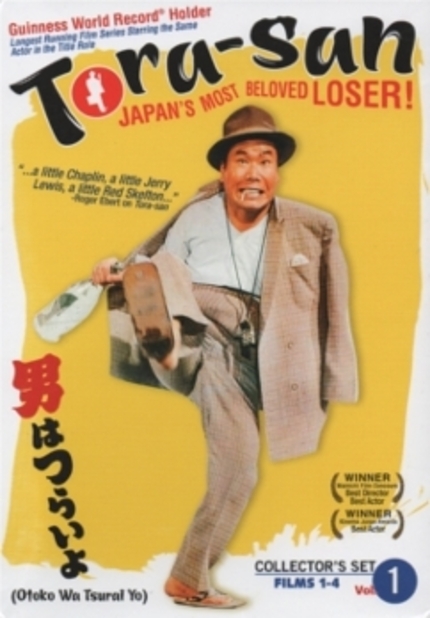DVD Review: TORA-SAN Collector's Set Volume 1

Volume One of the Tora-san collector's set covers the first four films: Tora-san, Our Lovable Tramp (1969), Tora-san's Cherished Mother (1969), Tora-san, His Tender Love (1970), and Tora-san's Grand Scheme (1970). Unbelievably, forty-eight of Tora-san films were made. Each film stars Kiyoshi Atsumi, who played the smash-faced yakuza drifter named Torajiro Kuruma (aka Tora-san). Yoji Yamada directed all but two of the films. Torajiro Kuruma is a two-sided character. On one hand, he is a bumbling tough guy whose non-stop banter about farting and peeing are a constant source of amusement. In addition to being a comical character, Torajiro Kuruma is also a tragic one whose clownish antics hide loneliness and his desire to connect with other people. The dual nature of the character matches the overall tone of the films, which reliably alternate between comical and sentimental moments.
In Tora-san, Our Lovable Tramp, Torajiro Kuruma wanders back to Shibamata neighborhood in Tokyo decades after running away. Upon his arrival, he reunites with his younger sister Sakura (Chieko Biasho), his aunt and his uncle. Torajiro Kuruma tries to blend in but his constant bullshitting and stubbornness gets in the way. When his uncle can't accompany Sakura to her omiai,Torajiro Kuruma goes in his place. Of course, he mucks up everything up and splits town in embarrassment. While in Kyoto, he stumbles across Gozen-sama of Taishaku-ten Temple (Chishu Ryu) and his daughter. Torajiro Kuruma quickly falls for the monk's daughter, and heads back to Shibamata with a new crush. Things work out for Sakura. However, Torajiro Kuruma's romance is mostly in his head, and by the end of the film, he drifts away again.
Describing the plots of the other three films isn't so useful because each film follows the exact same progression. Each film has a short introduction, which is followed by the same title sequence. Like a human boomerang, Torajiro Kuruma swings into Shibamata near the beginning of each film. He then starts raising hell, mucking up family business, and getting rejected by women. By the end, Torajiro Kuruma leaves Shibatama. Variations occur in the central plot, sub-plots, supporting characters and settings, but the films are very similar.
Even though the Tora-san films rely on a predictable formula, it is easy to tell why Shochiku cranked out so many of them: the formula works. The stories are light and breezy, the characters are sympathetic and Kiyoshi Atsumi's comedy is pretty funny. In a sense, Tora-san is reminiscent of episodic television, which isn't too surprising since the film series was actually preceded by a television show. Yoji Yamada's direction recalls the formalism of television: scenes are usually staged in confined spaces (offices, homes, restaurants) with an emphasis on ensemble acting. Whenever the films shift to outside locations, direction shows a bit more flair, turning the films into vivid travelogue that captures the beauty of the natural landscapes and the bustle of the cities. One gets the sense that part of the goal of the Tora-san films was to allow audiences to vicariously experience life in different parts of Japan.
AnimEigo went to great lengths to provide the best possible presentation of these films. The Tora-san films were shot in in 2:35:1 Cinemascope; the DVDs are in anamorphic widescreen with thin vertical black matting at the left and right side. One thing worth noting is that the curvature of the lens tends to jump out in the cinematography. It's unclear whether this is a result of the transfer or the original cinematography.Its not really an issue, but sometimes the framing is so wide that the lens distortion becomes apparent at the left and right edges (e.g., people at the edges look squashed).
The English subtitles are delivered in a interesting way. First, when multiple people are talking on screen, the subtitles for each speaker are given a different color to help differentiate the dialogue. Second, annotations are provided in white text in the top part of the frame. For instance, dialogue, scenery or situations that may be lost on non-Japanese speakers are explained in the annotations. Since the annotations and subtitles, which are in a big typeface, occur within the frame, the image can get crowded at times.
The level of context provides in the supplemental materials is impressive. A twenty-eight page booklet includes essays by Yoji Yamada, Donald Richie, and others. Stuart Galbraith IV provides an audio commentary for Tora-san, Our Lovable Tramp. The other films do not have an audio commentary. Each DVD contains program notes that further explain the locations and specific cultural references. Interactive maps of Japan allow the viewer to follow Torajiro Kuruma's drifting patterns throughout the series and see where locations in the films are in relation to each other.
In spite of the cliches and formulas, the films hold up quite well. Additionally, AnimEigo's exceptional presentation transforms these light breezy films into a detailed reference guide for a bygone era of Japanese cinema and culture.

Do you feel this content is inappropriate or infringes upon your rights? Click here to report it, or see our DMCA policy.






